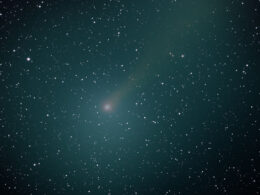Mystery solved: read our update below!
In a remarkable cosmic event, a supermassive black hole, equivalent to 20 million Suns, is racing through intergalactic space at a velocity so immense, it could span the Earth-Moon distance in just 14 minutes. This interstellar titan has crafted a never-before-seen spectacle: a “contrail” of newborn stars stretching 200,000 light-years, double the diameter of our Milky Way.

A Galactic Billiards Game
This phenomenon appears to stem from a rare and complex interaction involving three massive black holes, resembling a galactic game of billiards. Instead of behaving like a cosmic Pac-Man, devouring stars in its path, this swift-moving black hole compresses gas ahead of it, triggering a cascade of new star formation along a narrow corridor. This process has left a striking trail of stars, captured inadvertently by the Hubble Space Telescope.
The Stellar Wake: A Trail of Discovery
At the forefront of this discovery is Pieter van Dokkum from Yale University, who initially stumbled upon this phenomenon while investigating an unrelated dwarf galaxy. The unique aspect of this discovery is the bright knot of ionized oxygen observed at the tip of the star column, which indicates a shockwave effect from the black hole’s high-velocity movement through gas.
This star trail, described by van Dokkum as “quite astonishing, very, very bright and very unusual,” suggests a dynamic past involving multiple galactic collisions. The initial merger of two galaxies brought together their central supermassive black holes, forming a binary system. A subsequent collision with a third galaxy caused a chaotic dance, eventually ejecting one black hole and potentially altering the binary pair.
The Mystery Continues: Searching for Answers
The peculiarity of this event lies not only in the star trail but also in the absence of any active black hole at the galaxy’s core. This suggests a significant rearrangement in the galactic center. The next steps involve follow-up observations with NASA’s James Webb Space Telescope and the Chandra X-ray Observatory to further explore and confirm this extraordinary hypothesis.
This discovery, a blend of serendipity and meticulous investigation, offers a rare glimpse into the dynamic processes governing galaxies and their central black holes. It challenges our understanding of galactic dynamics and opens new frontiers in astrophysical research, reaffirming the universe’s capacity to surprise and intrigue us. Stay tuned as we delve deeper into this cosmic mystery, unraveling the secrets of this runaway supermassive black hole and its starry trail.
Mystery Solved

New research from the Instituto de Astrofisica de Canarias (IAC) has unveiled a surprising twist. The feature, once thought to be a trail left by a rogue black hole, is now believed to be a flat disk galaxy, viewed edge-on. This revelation came after comparisons with IC5249, a well-studied bulge-less galaxy similar in mass to the observed ‘trail.’
The IAC team’s investigation revealed that the motions, sizes, and star quantities are consistent with those seen in typical galaxies. Further analysis showed that the velocities of the distant star structure were akin to rotating galaxies, leading to the conclusion that what was perceived as a starry tail is behaving as a galaxy itself.
Closing Thoughts: The Ever-Evolving Universe
While the idea of a runaway black hole was tantalizing, the discovery of a large, distant galaxy provides its own intrigue. This development underscores the dynamic and unexpected nature of astronomical research. Each observation, whether it upholds or challenges our theories, enriches our understanding of the vast and surprising universe we inhabit.
Stay tuned as we continue to explore the cosmos, uncovering its mysteries and marvels, one observation at a time.





